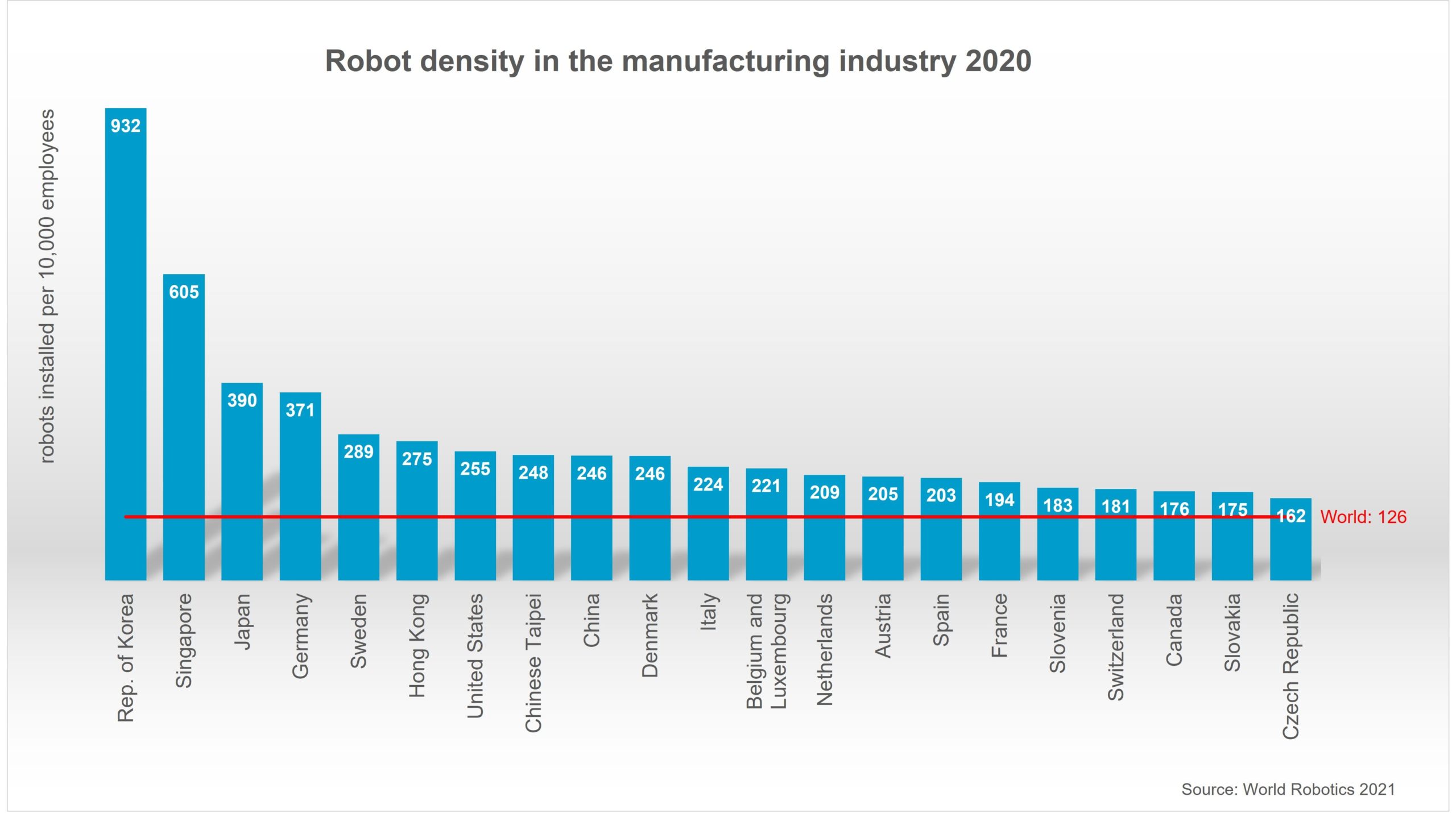|
Listen to this article  |
There are more than three million industrial robots operating in factories around the world, according to the International Federation of Robotics (IFR). In 2020, there was $13.2 billion of new robot installations.
Robot density, a metric used by the IFR, measures the number of robots per 10,000 workers in an industry. From 2015 to 2020, robot density nearly doubled worldwide, jumping from 66 units in 2015 to 126 units in 2020. In 2020 alone, robot density globally jumped from 113 units in 2019 to 126 units.
Regionally, Asia has the highest robot density in 2020, sitting above the global average at 134 units. Europe is slightly below the global average, with 123 units, followed by the Americas with 111 units.
In 2020, South Korea took back the top spot on the IFR’s list of most automated countries, bumping Singapore to the number two spot. After Singapore, the most automated countries were Japan, Germany, Sweden, Hong Kong, United States, Chinese Taipei, China and Denmark, which are tied for ninth, and Italy.
Hong Kong moved up one spot on the list, going from sixth to seventh, while the U.S. went up two spots, from ninth to seventh. China saw the greatest jump in spots, going from fifteenth to ninth, while Denmark dropped from sixth to ninth.

The countries with the most automation in manufacturing industries in 2020. | Credit: International Federation of Robotics
10. Italy
Industrial robots per 10K employees: 224
Italy went from 212 units in 2019 to 224 units in 2020. The country’s spot on the list is slightly higher than last year, when they sat at eleventh, but it only made it into the top ten due to a tie. Italy is the fourth-highest ranking EU country, after Germany, Sweden and Denmark.
9. China and Denmark
Industrial robots per 10K employees: 246
China and Denmark tied this year, both with 246 units. China saw the biggest jump on the list, and has seen a large increase in the last five years. In 2015, it had just 49 units and was ranked 25th. Last year, it had 187 units.
Denmark dropped three places this year, only adding 3 units per 10,000 employees since 2019, when it had 243 units. Home to big name robotics companies like Universal Robots, Denmark’s Odense robotics cluster is still a world leader in innovation.
8. Chinese Taipei (Taiwan)
Industrial robots per 10K employees: 248
Chinese Taipei holds its eighth place spot, even though it increased its density from 234 units in 2019. In 2017, Taipei began a $117 million smart machinery initiative as part of the country’s 5+2 Industrial Innovation Plan.
7. United States
Industrial robots per 10K employees: 255
The U.S. moved up two places from last year, adding 27 units since 2019. Growth in automation in the U.S. hasn’t slowed in 2021, as the North American robotics industry saw record numbers of orders in just the first nine months of the year.
6. Hong Kong
Industrial robots per 10K employees: 275
Hong Kong added 33 units per 10,000 employees in 2020, bumping the country up one spot on the list.
5. Sweden
Industrial robots per 10K employees: 289
Sweden stayed in the fifth spot on the list, adding 15 units per 10,000 employees in 2020. While Sweden rounds out the top half of the list, it sits far below Germany’s robot density.
4. Germany
Industrial robots per 10K employees: 371
Germany is Europe’s most automated country, retaining its fourth place spot on the list. The country added 25 units per 10,000 employees in 2020. It made up 33% of all robot sales in Europe in 2020. Much of Germany’s robotics industry is driven by overseas business rather than business in Europe or within Germany, according to the IFR.
3. Japan
Industrial robots per 10K employees: 390
Japan remains in the same spot as 2019. According to the IFR, Japan is the world’s predominant industrial robot manufacturer. In 2020, Japanese suppliers reached 174,000 units. Japanese manufacturers make up 45% of the global robot supply.
2. Singapore
Industrial robots per 10K employees: 605
Singapore is the only country on the list that saw a decrease in the number of industrial robots per 10,000 employees, with its numbers dropping from 918 units in 2019 to 605 in 2020. Part of this drop is likely due to the IFR’s change in reporting for its most recent report. Previously, the IFR relied on employment data from the International Labor Organization (ILO). For the 2020 report, the IFR used data from the Singapore Department of Statistics (DoS).
The ILO reported much lower employment counts than the DoS. This discrepancy helps to explain Singapore’s significant drop from the number one spot, which the country had in the 2019 report. Still, Singapore is a leader in automation. The country’s robot density has grown 27% on average each year since 2015.
1. South Korea
Industrial robots per 10K employees: 932
It’s no surprise South Korea leads the world in robot density. South Korea’s robot density is seven times higher than the global average, and the country has been increasing its robot density by 10% every year since 2015.
South Korea has a strong foothold in two key areas for industrial robotics: electronics and automotives. While South Korea was second on the 2019 list, it had previously held the top spot since 2010.
Credit: Source link


Comments are closed.